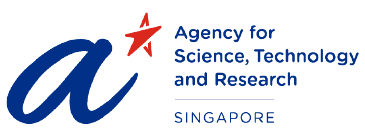27 Feb 2025
Pascale Senellart, CNRS, University Paris Saclay
CQT Level 3 Seminar room, S15-03-15
20 Feb 2025
Aephraim Steinberg, University of Toronto
CQT Level 3 Seminar room, S15-03-15
10 Jan 2025

Steven Chu, Stanford University
Lecture Theatre 31
14 Nov 2024

Lu Zheng-Tian, University of Science and Technology of China
CQT Level 3 Seminar room, S15-03-15
24 Oct 2024

Gerhard Rempe, Max Planck Institute of Quantum Optics
CQT Level 3 Seminar Room, S15-03-15
26 Sep 2024

Simon Cornish, Durham University
CQT Level 3 Seminar Room, S15-03-15
03 Sep 2024

Edward Yu, University of Texas
CQT Level 3 Seminar room, S15-03-15
06 Jun 2024

Robert Raussendorf, Leibniz University Hannover
CQT Level 3 Seminar Room
16 May 2024

Daniel Lidar, University of Southern California
CQT Level 3 Seminar Room
13 May 2024

Zhang Qiang, University of Science and Technology of China
CQT Level 3 Seminar Room, S15-03-15
26 Mar 2024

Jonathan Simon, Stanford University
CQT Level 3 Seminar Room, S15-03-15
29 Feb 2024

Yury Kurochkin, Technology Innovation Institute
CQT Level 3 Seminar Room, S15-03-15
25 Jan 2024

Zhen-Sheng Yuan, USTC
CQT Level 3 Seminar Room, S15-03-15
19 Oct 2023

Monika Aidelsburger, Max Planck Institute of Quantum Optics, Ludwig Maximilian University of Munich & Munich Centre for Quantum Science and Technology
CQT Level 3 Seminar Room, S15-03-15
05 Oct 2023

Iacopo Carusotto, Pitaevskii BEC Center, CNR-INO & University of Trento
CQT Level 3 Seminar Room, S15-03-15
24 Aug 2023

Anurag Anshu, Harvard University
CQT Level 3 Seminar Room, S15-03-15
17 Aug 2023

Mark Hillery, Hunter College
CQT Level 3 Seminar Room, S15-03-15
22 Jun 2023

Alexander Lvovsky, University of Oxford
CQT Level 3 Seminar Room, S15-03-15
08 Jun 2023

Jon Allcock, Tencent
CQT Level 3 Seminar Room, S15-03-15
12 Apr 2023

Ian B. Spielman, NIST
CQT Level 3 Seminar Room, S15-03-15
23 Mar 2023

Oriol Romero-Isart, IQOQI & University of Innsbruck
CQT Level 3 Seminar Room, S15-03-15
08 Feb 2023

Jerzy CiosĂ
?owski, University of Szczecin
Lecture Theatre 27
19 Jan 2023

Dagmar Bruss, University of Duesseldorf, Institute for Theoretical Physics III
Level 3 Seminar Room, S15-03-15
10 Nov 2022

Alexia AuffĂšves, Institut Neel - CNRS
Level 3 Seminar Room, S15-03-15
19 Oct 2022

Lam Ping Koy, IMRE A*STAR
LT 28, NUS
22 Sep 2022

Reinhard Werner, University of Hannover
Level 3 Seminar Room, S15-03-15
18 Aug 2022

Nicholas Bigelow, University of Rochester
Level 3 Seminar Room, S15-03-15
14 Jul 2022

Michael Tobar, University of Western Australia
CQT Level 3 Seminar Room, S15-03-15
28 Apr 2022

Nicolas Brunner, University of Geneva
Online via Zoom
17 Mar 2022

Pieter Kok, The University of Sheffield
Online via Zoom
17 Feb 2022

Alexander Lvovsky, University of Oxford
Online via Zoom
20 Jan 2022

Jerome Faist, ETH ZĂŒrich
Online via Zoom
25 Nov 2021

Ulrik Lund Andersen, Technical University of Denmark
Online via Zoom
28 Oct 2021

Ron Folman, Ben-Gurion University of the Negev
Online via Zoom
26 Aug 2021

Marcin Pawlowski, University of Gdansk, Poland
Online via Zoom
27 May 2021

Marlan Scully, Texas A&M, Princeton, and Baylor Universities
Online via Zoom
29 Apr 2021

Renato Renner, ETH
Online Event
25 Mar 2021

Steven Girvin, Yale University
Online Event
18 Feb 2021

John Chiaverini, MIT
Online Event
19 Nov 2020

Giuseppe Carleo, EPFL
Online Event
29 Oct 2020

Rodney Van Meter, Keio University
Online via Zoom
24 Sep 2020
Ernst M. Rasel, Institute of Quantum Optics, Leibniz University Hannover
Online Event
20 Aug 2020

Barry C. Sanders, University of Calgary
Online Event
06 Feb 2020

Chiara Marletto, University of Oxford
CQT Level 3 Seminar Room, S15-03-15
09 Jan 2020

Konrad Banaszek, Centre for Quantum Optical Technologies and Faculty of Physics, University of Warsaw, Poland
CQT Level 3 Seminar Room, S15-03-15
21 Nov 2019

Rubem Mondaini, Beijing Computational Sciences Research Center
CQT Level 3 Seminar Room, S15-03-15
10 Oct 2019

Cheng Chin, James Franck institute, Enrico Fermi institute, University of Chicago
CQT Level 3 Seminar Room, S15-03-15
19 Sep 2019

Georgy Shlyapnikov, LPTMS, CNRS, Orsay, France
CQT Level 3 Seminar Room, S15-03-15
29 Aug 2019

Thomas Jennewein, IQC, University of Waterloo
CQT Level 3 Seminar Room, S15-03-15
09 May 2019

Yoshiro Takahashi, Kyoto University, Kyoto, Japan
CQT Level 3 Seminar Room, S15-03-15
18 Apr 2019

Noah Stephens-Davidowitz, MIT
CQT Level 3 Seminar Room, S15-03-15
07 Mar 2019

Marco Genovese, INRIM
CQT Level 3 Seminar Room, S15-03-15
28 Feb 2019

Gabriel Landi, University of SĂŁo Paulo
CQT Level 3 Seminar Room, S15-03-15
20 Dec 2018

Hoi-Kwong Lo, University of Toronto
CQT Level 3 Seminar Room, S15-03-15
22 Nov 2018

Mikhail Baranov, Institute for Quantum Optics and Quantum Information, Austrian Academy of Sciences
CQT Level 3 Seminar Room, S15-03-15
18 Oct 2018

Timothy C. Ralph, Centre for Quantum Computation & Communication Technology, The University of Queensland
CQT Level 3 Seminar Room, S15-03-15
13 Sep 2018
Morgan W. Mitchell, ICFO - The Institute of Photonic Sciences
CQT Level 3 Seminar Room, S15-03-15
21 Jun 2018

Mile Gu, CQT, NUS & NTU
CQT Level 3 Seminar Room, S15-03-15
28 Mar 2018

Pedram Roushan, Google Inc., Santa Barbara, USA
CQT Level 3 Seminar Room, S15-03-15
01 Mar 2018

Kazimierz Rzazewski, Center for Theoretical Physics, Polish Academy of Sciences
CQT Level 3 Seminar Room, S15-03-15
31 Jan 2018

Claude Fabre, Laboratoire Kastler Brossel, Sorbonne Universite, Paris
CQT Level 3 Seminar Room, S15-03-15
18 Jan 2018

Mark Saffman, University of Wisconsin-Madison
CQT Level 3 Seminar Room, S15-03-15
23 Nov 2017


Divesh Aggarwal, CQT, NUS
CQT Level 3 Seminar Room, S15-03-15
02 Nov 2017
Nobuyuki Imoto, Osaka University
CQT Level 3 Seminar Room, S15-03-15
26 Oct 2017


Wenhui Li, Centre for Quantum Technologies, NUS
CQT Seminar Room, S15-03-15
19 Oct 2017
Ronnie Kosloff, Hebrew University
CQT Seminar Room, S15-03-15
07 Sep 2017

Katsunari Okamoto, Okamoto Laboratory, Japan
CQT Seminar Room, S15-03-15
31 Aug 2017


Berge Englert, CQT, NUS
CQT Seminar Room, S15-03-15
27 Jul 2017


Dimitris Angelakis, CQT, NUS
CQT Seminar Room, S15-03-15
18 May 2017


Joe Fitzsimons, CQT, NUS & SUTD
CQT Seminar Room, S15-03-15
27 Apr 2017


Valerio Scarani, CQT, NUS
CQT Seminar Room, S15-03-15
23 Mar 2017


Vlatko Vedral, CQT, NUS
CQT Seminar Room, S15-03-15
02 Feb 2017

Fernando Pastawski, Institute for Quantum Information and Matter (IQIM)
CQT Seminar Room, S15-03-15
13 Jan 2017

James P. Crutchfield, University of California at Davis
CQT Seminar Room, S15-03-15
07 Dec 2016

Markus Arndt, University of Vienna, Austria
Auditorium 1 Level 1, Town Plaza University Town, NUS
07 Dec 2016

Edward Farhi MIT, USA
Auditorium 1 Level 1, Town Plaza University Town, NUS
17 Nov 2016

Jake Taylor, Joint Center for Quantum Information and Computer Science, Joint Quantum Institute, National Institute of Standards and Technology
CQT Seminar Room, S15-03-15
10 Nov 2016

Jean-François ROCH, Université Paris-Saclay
CQT Seminar Room, S15-03-15
22 Sep 2016

Eberhard Widmann, Austrian Academy of Sciences
CQT Seminar Room, S15-03-15
28 Jul 2016
Alexandra Olaya-Castro, University College London
CQT Seminar Room, S15-03-15
14 Apr 2016

Klaus Blaum, Max Planck Institute for Nuclear Physics
CQT Seminar Room, S15-03-15
07 Apr 2016

Giovanni Amelino-Camelia, University of Rome La Sapienza
CQT Seminar Room, S15-03-15
30 Mar 2016

Robert Taylor, University of Oxford
Photonic Crystals and Photonic Molecules at Telcom Wavelengths
10 Mar 2016

Gregory Chaitin, Federal University of Rio de Janeiro
CQT Seminar Room, S15-03-15
18 Feb 2016

Ryan O'Donnell, Carnegie Mellon University
CQT Seminar Room, S15-03-15
07 Dec 2015

Stanley Williams, Hewlett Packard Labs, USA
University Hall Auditorium Level 2, Lee Kong Chian Wing University Hall, NUS
07 Dec 2015

Serge Massar, Université Libre de Bruxelles, Belgium
University Hall Auditorium Level 2, Lee Kong Chian Wing University Hall, NUS
20 Aug 2015

Scott Aaronson , Massachusetts Institute of Technology
CQT Seminar Room, S15-03-15
28 May 2015
Tilman Pfau, University of Stuttgart
CQT Seminar Room, S15-03-15
16 Apr 2015

Charles Adams, Durham University
CQT Seminar Room, S15-03-15
08 Dec 2014

Valerio Scarani, Centre for Quantum Technologies, NUS
Ngee Ann Kongsi Auditorium Level 2 Education Resource Centre University Town, NUS
08 Dec 2014
Rainer Blatt, University of Innsbruck, Austria
Ngee Ann Kongsi Auditorium Level 2 Education Resource Centre University Town, NUS
08 Dec 2014
Aram Harrow, Massachusetts Institute of Technology, USA
Ngee Ann Kongsi Auditorium Level 2 Education Resource Centre University Town, NUS
07 Nov 2014
William D. Phillips, Nobel Prize in Physics 1997, National Institute of Standards and Technology, University of Maryland
CQT Seminar Room, S15-03-15
15 Oct 2014
Gianni Blatter, ETH Zurich
CQT Seminar Room, S15-03-15
04 Sep 2014

Guenter Werth, Johannes Gutenberg University, Mainz/Germany
CQT Seminar Room, S15-03-15
19 Aug 2014
Christophe Salomon, Laboratoire Kastler Brossel, Ecole Normale Supérieure, Paris, France
CQT Seminar Room, S15-03-15
03 Jul 2014
John Rarity, University of Bristol
CQT Seminar Room, S15-03-15
13 Mar 2014
Joseph Eberly, Center for Coherence and Quantum Optics, University of Rochester
CQT Seminar Room, S15-03-15
27 Feb 2014
Amir O. Caldeira, Universidade Estadual de Campinas - Instituto de FĂsica
CQT Seminar Room, S15-03-15
06 Dec 2013
Alexander Ling, Centre for Quantum Technologies, NUS
Ngee Ann Auditorium, Asian Civilisations Museum, 1 Empress Place, Singapore 179555
06 Dec 2013
Richard Cleve, University of Waterloo
Ngee Ann Auditorium, Asian Civilisations Museum, 1 Empress Place, Singapore 179555
06 Dec 2013
Yasunobu Nakamura Research Center for Advanced Science and technology (RCAST), The University of Tokyo Center for Emergent Matter Science (CEMS),
Ngee Ann Auditorium, Asian Civilisations Museum, 1 Empress Place, Singapore 179555
28 Nov 2013
Masanao Ozawa, Nagoya University
CQT Seminar Room, S15-03-15
03 Oct 2013
Michael Berry, University of Bristol
CQT Seminar Room, S15-03-15
25 Jul 2013
Jukka Pekola, Aalto University
CQT Seminar Room, S15-03-15
18 Jul 2013
Terry Rudolph, Imperial College
CQT Seminar Room, S15-03-15
16 May 2013

José Ignacio Latorre, Universitat de Barcelona
CQT Seminar Room, S15-03-15
04 Apr 2013
Masahito Ueda, The University of Tokyo
CQT Seminar Room, S15-03-15
21 Mar 2013

Miguel Angel Martin-Delgado, Universidad Complutense de Madrid
CQT Seminar Room, S15-03-15
23 Jan 2013

Eric Cornell, JILA
CQT Seminar Room, S15-03-15
07 Dec 2012

Peter Knight, Imperial College, UK
NUS Kent Ridge, University Hall Auditorium, Level 2, Lee Kong Chian Wing
07 Dec 2012

Avi Wigderson, Institute for Advanced Study, Princeton, USA
NUS Kent Ridge, University Hall Auditorium, Level 2, Lee Kong Chian Wing
29 Nov 2012

Andrey Varlamov, Institute of Superconductivity and Innovation Materials (SPIN-CNR), Italy
CQT Seminar Room, S15-03-15
25 Oct 2012

Andrey Morello, ARC Centre of Excellence Centre for Quantum Computation and Communication Technology, The University of New South Wales
CQT Seminar Room, S15-03-15
06 Sep 2012

Dimitris Charalambidis, University of Crete and Institute of Electronic Structure and Laser (IESL), FORTH
CQT Seminar Room, S15-03-15
02 Aug 2012

Yuval Gefen, Weizmann Institute of Science
CQT Seminar Room, S15-03-15
26 Jul 2012

Peter Hanggi, University of Augsburg
CQT Seminar Room, S15-03-15
24 May 2012

Philippe Bouyer, Laboratoire Charles Fabry, France
CQT Seminar Room, S15-03-15
08 Mar 2012

Gershon Kurizki, Weizmann Institute of Science, Israel
CQT Seminar Room, S15-03-15
09 Feb 2012

Guido Burkard, Department of Physics, University of Konstanz, Germany
CQT Seminar Room, S15-03-15
12 Jan 2012

Raymond Laflamme, IQC, Waterloo, Canada
CQT Seminar Room, S15-03-15
12 Jan 2012

Wojciech Zurek, Los Alamos National Laboratory, USA
CQT Seminar Room, S15-03-15
07 Dec 2011

Immanuel BLOCH, Max-Planck-Institut fĂŒr Quantenoptik
NUS University Hall Auditorium, Lee Kong Chian Wing, Level 2
07 Dec 2011

Harry BUHRMAN, Centrum Wiskunde & Informatica (CWI) & University of Amsterdam
NUS Kent Ridge, University Hall Auditorium, Level 2, Lee Kong Chian Wing
24 Nov 2011

Elisabeth Giacobino, Laboratoire Kastler Brossel, Ecole Normale Supérieure, Université Pierre et Marie Curie, CNRS
CQT Seminar Room, S15-03-15
06 Oct 2011

AlĂĄn Aspuru-Guzik, Harvard University, USA
CQT Seminar Room, S15-03-15
11 Aug 2011

Michael Fleischhauer,UniversitÀt Kaiserslautern, Germany
CQT Seminar Room, S15-03-15
28 Jul 2011
Boris Altshuler, Columbia University, USA
CQT Seminar Room, S15-03-15
26 May 2011

Luca Turin, BSRC Fleming, Vari, Greece
CQT Seminar Room, S15-03-15
24 Mar 2011
Tom Gallagher, University of Virginia, USA
CQT Seminar Room, S15-03-15
10 Feb 2011
Jeremy O'Brien, University of Bristol
CQT Seminar Room, S15-03-15
09 Feb 2011
Antonio Acin, ICFO, Barcelona (Spain)
CQT Seminar Room, S15-03-15
11 Jan 2011
Charles H. Bennett of IBM Research USA
Ngee Ann Kongsi Auditorium (Level 2), Singapore Management University
07 Dec 2010
Martin Plenio and Mario Szegedy
NUS University Hall Auditorium, Lee Kong Chian Wing, Level 2
07 Oct 2010
Lev Vaidman, Tel Aviv University
CQT Seminar Room, S15-03-15
09 Sep 2010
Daniel M. Greenberger, City University of New York
CQT Seminar Room, S15-03-15
20 Aug 2010
Carlton M. Caves, University of New Mexico
CQT Seminar Room, S15-03-15
10 Aug 2010
Christophe Salomon, Laboratoire Kastler Brossel, France
CQT Seminar Room, S15-03-15
27 May 2010
Sankar Das Sarma, University of Maryland
CQT Seminar Room, S15-03-15
22 Apr 2010
John Rarity, University of Bristol
CQT Seminar Room, S15-03-15
18 Mar 2010
Adrian Kent, Centre for Quantum Computation, University of Cambridge
CQT Seminar Room, S15-03-15
24 Feb 2010
Klaus MĂžlmer, Lundbeck Foundation Theoretical Center for Quantum System Research, University of Aarhus
CQT Seminar Room, S15-03-15
08 Dec 2009
Anton Zeilinger
NUS University Hall Auditorium, Lee Kong Chian Wing, Level 2
08 Dec 2009
Andrew Yao
NUS Kent Ridge, University Hall Auditorium, Level 2, Lee Kong Chian Wing
19 Nov 2009
Nicholas Bigelow, The Institute of Optics, University of Rochester
CQT Seminar Room, S15-03-15
29 Oct 2009
Jean Dalibard, Laboratoire Kastler Brossel
CQT Seminar Room, S15-03-15
03 Sep 2009
Lieven Vandersypen, Kavli Institute of Nanoscience, Delft University of Technology
CQT Seminar Room, S15-03-15
16 Apr 2009
Jörg Schmiedmayer, Atominstitut der ???sterreichischen UniversitÀten, TU-Wien
CQT Seminar Room, S15-03-15
02 Apr 2009
Serge Haroche, ENS and CollĂšge de France
CQT Seminar Room, S15-03-15
26 Mar 2009
Patrick Hayden, McGill University, Canada
CQT Seminar Room, S15-03-15
12 Feb 2009
Ian Walmsley, University of Oxford, UK.
CQT Seminar Room, S15-03-15
05 Feb 2009
Wolfgang Behr, University of Zurich, Switzerland
CQT Seminar Room, S15-03-15
20 Jan 2009
Seth Lloyd, Massachusetts Institute of Technology, USA
CQT Seminar Room, S15-03-15
03 Dec 2008
Philippe Grangier, Institut d'Optique, Palaiseau
NUS University Hall Auditorium, Lee Kong Chian Wing, Level 2
02 Dec 2008
Jun Ye, JILA, National Institute of Standards and Technology and University of Colorado
NUS University Hall Auditorium, Lee Kong Chian Wing, Level 2
02 Dec 2008
Alain Aspect, Institut dâOptique, Palaiseau
NUS University Hall Auditorium, Lee Kong Chian Wing, Level 2
02 Oct 2008
Kazimierz RzĂâŠĂ
?ewski
Physics Conference Room S13, Level M
28 Aug 2008
Dieter Jaksch
Physics Conference Room S13, Level M
17 Jul 2008
Rosario Fazio
Physics Conference Room S13, Level M
29 May 2008
Howard Carmichael
Physics Conference Room S13, Level M
17 Apr 2008
Scott Parkins
S16 - LT31
27 Mar 2008
Hans Briegel
S16 - LT31
28 Feb 2008
Nobuyuki Imoto
S16 - LT31
10 Jan 2008
Nicolas Gisin
CQT Seminar Room, S15-03-15
 27 Feb 2025Pascale Senellart, CNRS, University Paris Saclay
27 Feb 2025Pascale Senellart, CNRS, University Paris Saclay 20 Feb 2025Aephraim Steinberg, University of Toronto
20 Feb 2025Aephraim Steinberg, University of Toronto Steven Chu, Stanford University
Steven Chu, Stanford University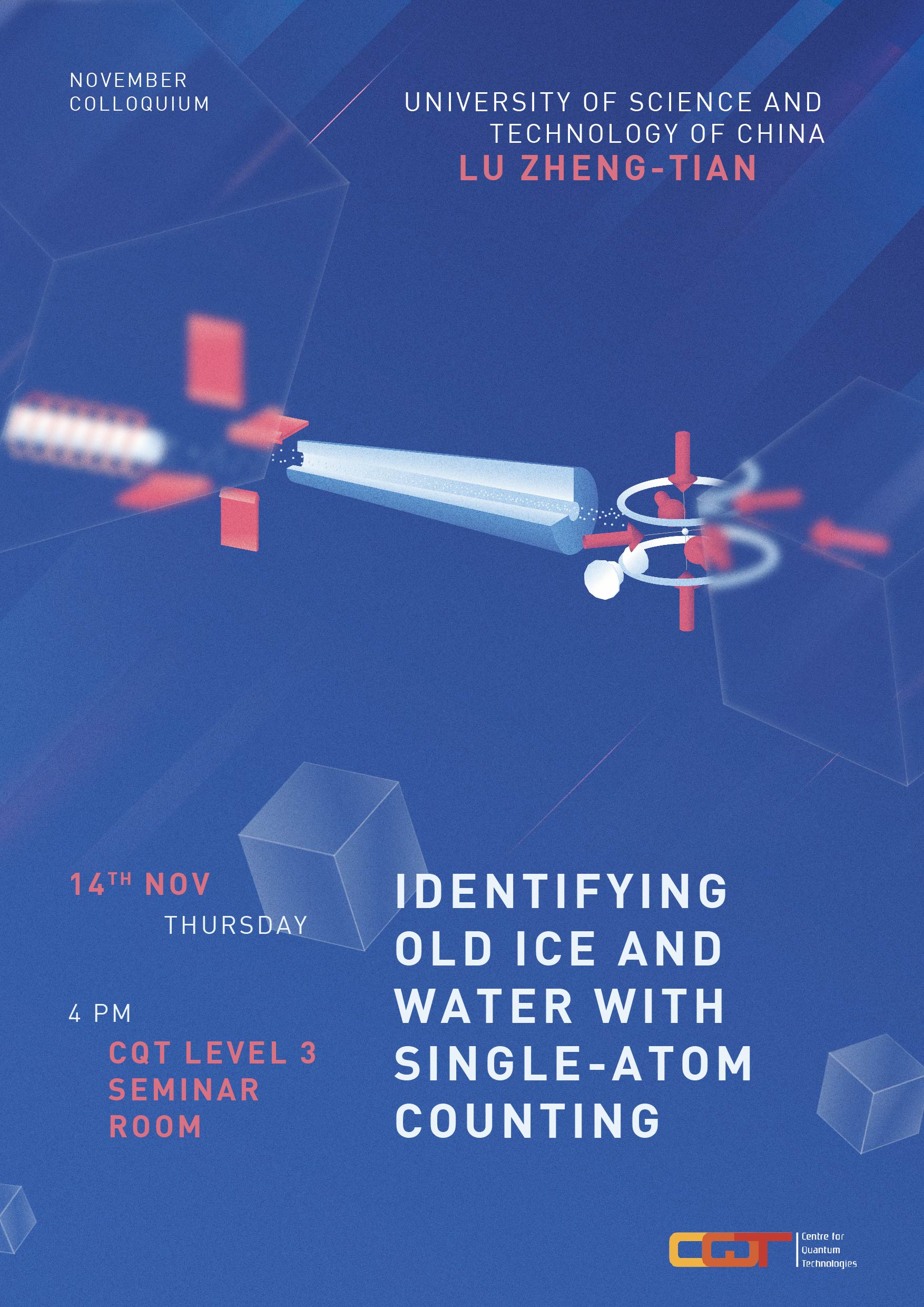 Lu Zheng-Tian, University of Science and Technology of China
Lu Zheng-Tian, University of Science and Technology of China Gerhard Rempe, Max Planck Institute of Quantum Optics
Gerhard Rempe, Max Planck Institute of Quantum Optics Simon Cornish, Durham University
Simon Cornish, Durham University Edward Yu, University of Texas
Edward Yu, University of Texas Robert Raussendorf, Leibniz University Hannover
Robert Raussendorf, Leibniz University Hannover Daniel Lidar, University of Southern California
Daniel Lidar, University of Southern California Zhang Qiang, University of Science and Technology of China
Zhang Qiang, University of Science and Technology of China Jonathan Simon, Stanford University
Jonathan Simon, Stanford University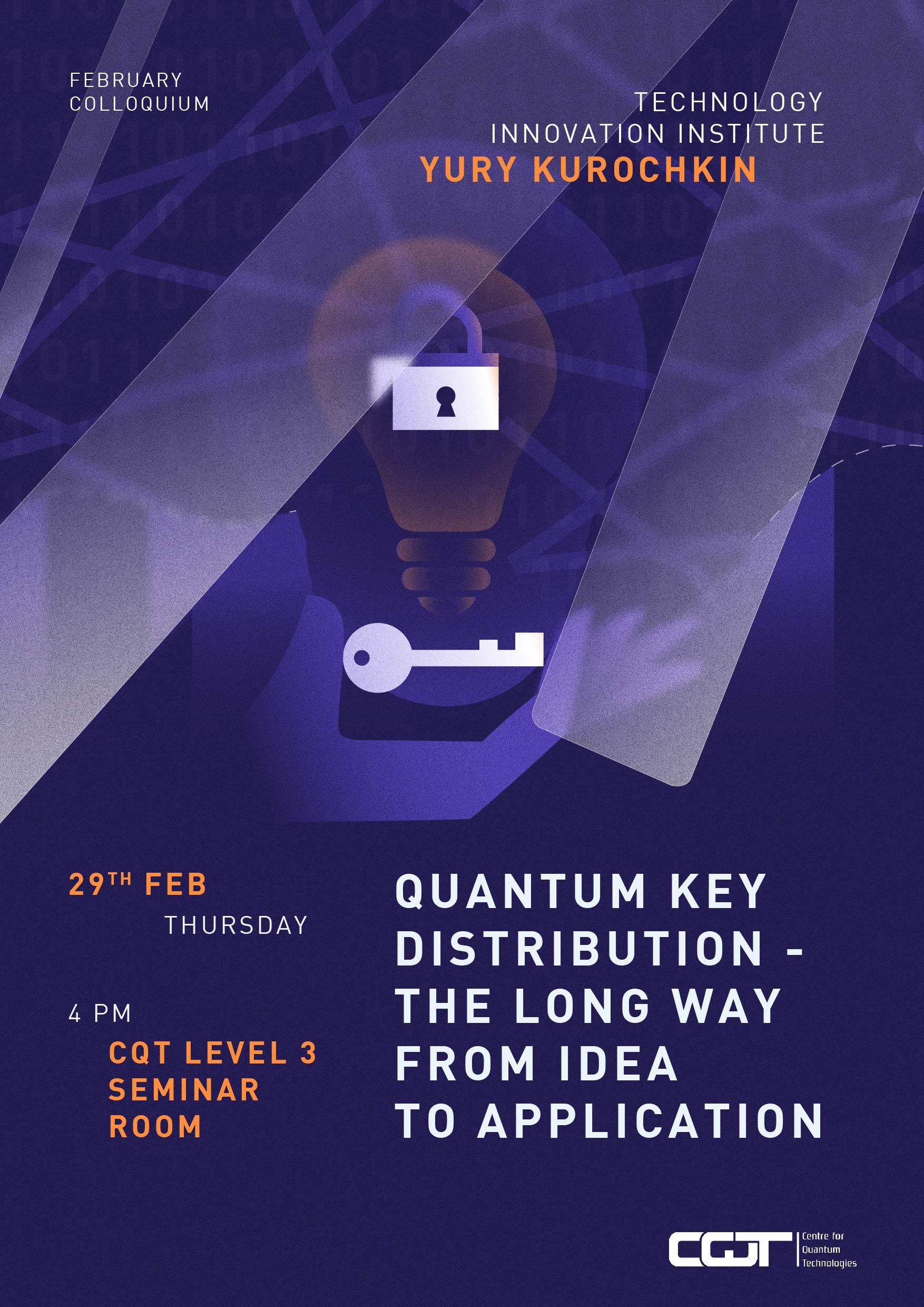 Yury Kurochkin, Technology Innovation Institute
Yury Kurochkin, Technology Innovation Institute Zhen-Sheng Yuan, USTC
Zhen-Sheng Yuan, USTC Monika Aidelsburger, Max Planck Institute of Quantum Optics, Ludwig Maximilian University of Munich & Munich Centre for Quantum Science and Technology
Monika Aidelsburger, Max Planck Institute of Quantum Optics, Ludwig Maximilian University of Munich & Munich Centre for Quantum Science and Technology Iacopo Carusotto, Pitaevskii BEC Center, CNR-INO & University of Trento
Iacopo Carusotto, Pitaevskii BEC Center, CNR-INO & University of Trento Anurag Anshu, Harvard University
Anurag Anshu, Harvard University Mark Hillery, Hunter College
Mark Hillery, Hunter College Alexander Lvovsky, University of Oxford
Alexander Lvovsky, University of Oxford Jon Allcock, Tencent
Jon Allcock, Tencent Ian B. Spielman, NIST
Ian B. Spielman, NIST Oriol Romero-Isart, IQOQI & University of Innsbruck
Oriol Romero-Isart, IQOQI & University of Innsbruck Jerzy CiosĂ ?owski, University of Szczecin
Jerzy CiosĂ ?owski, University of Szczecin Dagmar Bruss, University of Duesseldorf, Institute for Theoretical Physics III
Dagmar Bruss, University of Duesseldorf, Institute for Theoretical Physics III Alexia AuffĂšves, Institut Neel - CNRS
Alexia AuffĂšves, Institut Neel - CNRS Lam Ping Koy, IMRE A*STAR
Lam Ping Koy, IMRE A*STAR Reinhard Werner, University of Hannover
Reinhard Werner, University of Hannover Nicholas Bigelow, University of Rochester
Nicholas Bigelow, University of Rochester Michael Tobar, University of Western Australia
Michael Tobar, University of Western Australia Nicolas Brunner, University of Geneva
Nicolas Brunner, University of Geneva Pieter Kok, The University of Sheffield
Pieter Kok, The University of Sheffield Alexander Lvovsky, University of Oxford
Alexander Lvovsky, University of Oxford Jerome Faist, ETH ZĂŒrich
Jerome Faist, ETH ZĂŒrich Ulrik Lund Andersen, Technical University of Denmark
Ulrik Lund Andersen, Technical University of Denmark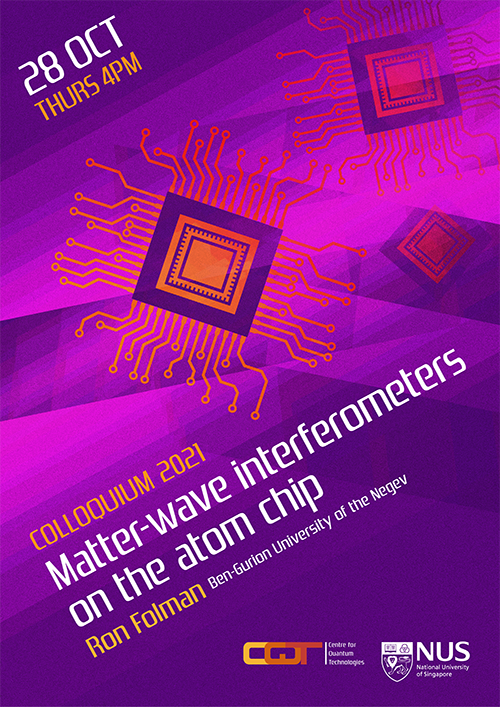 Ron Folman, Ben-Gurion University of the Negev
Ron Folman, Ben-Gurion University of the Negev Marcin Pawlowski, University of Gdansk, Poland
Marcin Pawlowski, University of Gdansk, Poland Marlan Scully, Texas A&M, Princeton, and Baylor Universities
Marlan Scully, Texas A&M, Princeton, and Baylor Universities Renato Renner, ETH
Renato Renner, ETH Steven Girvin, Yale University
Steven Girvin, Yale University John Chiaverini, MIT
John Chiaverini, MIT Giuseppe Carleo, EPFL
Giuseppe Carleo, EPFL Rodney Van Meter, Keio University
Rodney Van Meter, Keio University 24 Sep 2020Ernst M. Rasel, Institute of Quantum Optics, Leibniz University Hannover
24 Sep 2020Ernst M. Rasel, Institute of Quantum Optics, Leibniz University Hannover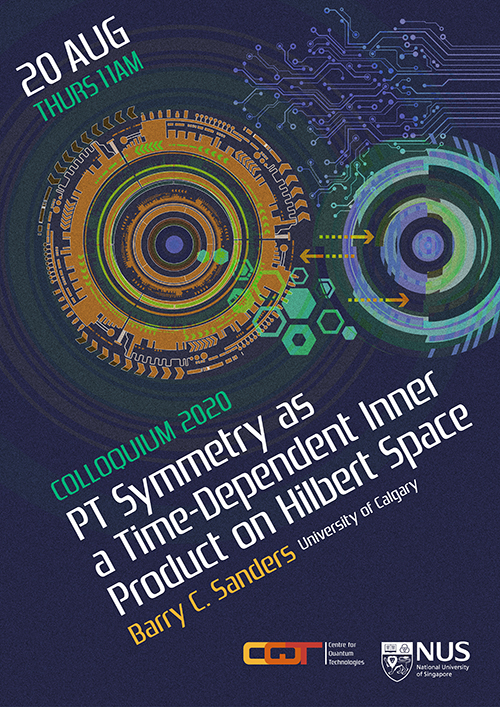 Barry C. Sanders, University of Calgary
Barry C. Sanders, University of Calgary Chiara Marletto, University of Oxford
Chiara Marletto, University of Oxford Konrad Banaszek, Centre for Quantum Optical Technologies and Faculty of Physics, University of Warsaw, Poland
Konrad Banaszek, Centre for Quantum Optical Technologies and Faculty of Physics, University of Warsaw, Poland Rubem Mondaini, Beijing Computational Sciences Research Center
Rubem Mondaini, Beijing Computational Sciences Research Center Cheng Chin, James Franck institute, Enrico Fermi institute, University of Chicago
Cheng Chin, James Franck institute, Enrico Fermi institute, University of Chicago Georgy Shlyapnikov, LPTMS, CNRS, Orsay, France
Georgy Shlyapnikov, LPTMS, CNRS, Orsay, France Thomas Jennewein, IQC, University of Waterloo
Thomas Jennewein, IQC, University of Waterloo Yoshiro Takahashi, Kyoto University, Kyoto, Japan
Yoshiro Takahashi, Kyoto University, Kyoto, Japan Noah Stephens-Davidowitz, MIT
Noah Stephens-Davidowitz, MIT Marco Genovese, INRIM
Marco Genovese, INRIM Gabriel Landi, University of SĂŁo Paulo
Gabriel Landi, University of SĂŁo Paulo Hoi-Kwong Lo, University of Toronto
Hoi-Kwong Lo, University of Toronto Mikhail Baranov, Institute for Quantum Optics and Quantum Information, Austrian Academy of Sciences
Mikhail Baranov, Institute for Quantum Optics and Quantum Information, Austrian Academy of Sciences Timothy C. Ralph, Centre for Quantum Computation & Communication Technology, The University of Queensland
Timothy C. Ralph, Centre for Quantum Computation & Communication Technology, The University of Queensland 13 Sep 2018Morgan W. Mitchell, ICFO - The Institute of Photonic Sciences
13 Sep 2018Morgan W. Mitchell, ICFO - The Institute of Photonic Sciences Mile Gu, CQT, NUS & NTU
Mile Gu, CQT, NUS & NTU Pedram Roushan, Google Inc., Santa Barbara, USA
Pedram Roushan, Google Inc., Santa Barbara, USA Kazimierz Rzazewski, Center for Theoretical Physics, Polish Academy of Sciences
Kazimierz Rzazewski, Center for Theoretical Physics, Polish Academy of Sciences Claude Fabre, Laboratoire Kastler Brossel, Sorbonne Universite, Paris
Claude Fabre, Laboratoire Kastler Brossel, Sorbonne Universite, Paris Mark Saffman, University of Wisconsin-Madison
Mark Saffman, University of Wisconsin-Madison Divesh Aggarwal, CQT, NUS
Divesh Aggarwal, CQT, NUS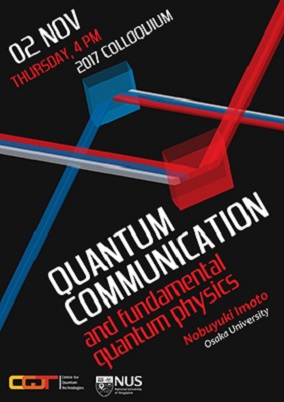 02 Nov 2017Nobuyuki Imoto, Osaka University
02 Nov 2017Nobuyuki Imoto, Osaka University Wenhui Li, Centre for Quantum Technologies, NUS
Wenhui Li, Centre for Quantum Technologies, NUS 19 Oct 2017Ronnie Kosloff, Hebrew University
19 Oct 2017Ronnie Kosloff, Hebrew University Katsunari Okamoto, Okamoto Laboratory, Japan
Katsunari Okamoto, Okamoto Laboratory, Japan Berge Englert, CQT, NUS
Berge Englert, CQT, NUS Dimitris Angelakis, CQT, NUS
Dimitris Angelakis, CQT, NUS Joe Fitzsimons, CQT, NUS & SUTD
Joe Fitzsimons, CQT, NUS & SUTD Valerio Scarani, CQT, NUS
Valerio Scarani, CQT, NUS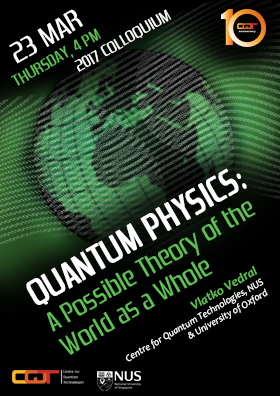 Vlatko Vedral, CQT, NUS
Vlatko Vedral, CQT, NUS Fernando Pastawski, Institute for Quantum Information and Matter (IQIM)
Fernando Pastawski, Institute for Quantum Information and Matter (IQIM) James P. Crutchfield, University of California at Davis
James P. Crutchfield, University of California at Davis Markus Arndt, University of Vienna, Austria
Markus Arndt, University of Vienna, Austria The Quantum Approximate Optimization Algorithm: A Good Choice to Run on a Near Term Quantum ComputerEdward Farhi MIT, USA
The Quantum Approximate Optimization Algorithm: A Good Choice to Run on a Near Term Quantum ComputerEdward Farhi MIT, USA Jake Taylor, Joint Center for Quantum Information and Computer Science, Joint Quantum Institute, National Institute of Standards and Technology
Jake Taylor, Joint Center for Quantum Information and Computer Science, Joint Quantum Institute, National Institute of Standards and Technology Jean-François ROCH, Université Paris-Saclay
Jean-François ROCH, Université Paris-Saclay Eberhard Widmann, Austrian Academy of Sciences
Eberhard Widmann, Austrian Academy of Sciences 28 Jul 2016Alexandra Olaya-Castro, University College London
28 Jul 2016Alexandra Olaya-Castro, University College London Klaus Blaum, Max Planck Institute for Nuclear Physics
Klaus Blaum, Max Planck Institute for Nuclear Physics Giovanni Amelino-Camelia, University of Rome La Sapienza
Giovanni Amelino-Camelia, University of Rome La Sapienza Robert Taylor, University of Oxford
Robert Taylor, University of Oxford Gregory Chaitin, Federal University of Rio de Janeiro
Gregory Chaitin, Federal University of Rio de Janeiro Ryan O'Donnell, Carnegie Mellon University
Ryan O'Donnell, Carnegie Mellon University Stanley Williams, Hewlett Packard Labs, USA
Stanley Williams, Hewlett Packard Labs, USA Serge Massar, Université Libre de Bruxelles, Belgium
Serge Massar, Université Libre de Bruxelles, Belgium Scott Aaronson , Massachusetts Institute of Technology
Scott Aaronson , Massachusetts Institute of Technology 28 May 2015Tilman Pfau, University of Stuttgart
28 May 2015Tilman Pfau, University of Stuttgart Charles Adams, Durham University
Charles Adams, Durham University Valerio Scarani, Centre for Quantum Technologies, NUS
Valerio Scarani, Centre for Quantum Technologies, NUS 08 Dec 2014Rainer Blatt, University of Innsbruck, Austria
08 Dec 2014Rainer Blatt, University of Innsbruck, Austria 08 Dec 2014Aram Harrow, Massachusetts Institute of Technology, USA
08 Dec 2014Aram Harrow, Massachusetts Institute of Technology, USA 07 Nov 2014William D. Phillips, Nobel Prize in Physics 1997, National Institute of Standards and Technology, University of Maryland
07 Nov 2014William D. Phillips, Nobel Prize in Physics 1997, National Institute of Standards and Technology, University of Maryland 15 Oct 2014Gianni Blatter, ETH Zurich
15 Oct 2014Gianni Blatter, ETH Zurich Guenter Werth, Johannes Gutenberg University, Mainz/Germany
Guenter Werth, Johannes Gutenberg University, Mainz/Germany 19 Aug 2014Christophe Salomon, Laboratoire Kastler Brossel, Ecole Normale Supérieure, Paris, France
19 Aug 2014Christophe Salomon, Laboratoire Kastler Brossel, Ecole Normale Supérieure, Paris, France 03 Jul 2014John Rarity, University of Bristol
03 Jul 2014John Rarity, University of Bristol 13 Mar 2014Joseph Eberly, Center for Coherence and Quantum Optics, University of Rochester
13 Mar 2014Joseph Eberly, Center for Coherence and Quantum Optics, University of Rochester 27 Feb 2014Amir O. Caldeira, Universidade Estadual de Campinas - Instituto de FĂsica
27 Feb 2014Amir O. Caldeira, Universidade Estadual de Campinas - Instituto de FĂsica 06 Dec 2013Alexander Ling, Centre for Quantum Technologies, NUS
06 Dec 2013Alexander Ling, Centre for Quantum Technologies, NUS 06 Dec 2013Richard Cleve, University of Waterloo
06 Dec 2013Richard Cleve, University of Waterloo 06 Dec 2013Yasunobu Nakamura Research Center for Advanced Science and technology (RCAST), The University of Tokyo Center for Emergent Matter Science (CEMS),
06 Dec 2013Yasunobu Nakamura Research Center for Advanced Science and technology (RCAST), The University of Tokyo Center for Emergent Matter Science (CEMS), 28 Nov 2013Masanao Ozawa, Nagoya University
28 Nov 2013Masanao Ozawa, Nagoya University 03 Oct 2013Michael Berry, University of Bristol
03 Oct 2013Michael Berry, University of Bristol 25 Jul 2013Jukka Pekola, Aalto University
25 Jul 2013Jukka Pekola, Aalto University 18 Jul 2013Terry Rudolph, Imperial College
18 Jul 2013Terry Rudolph, Imperial College José Ignacio Latorre, Universitat de Barcelona
José Ignacio Latorre, Universitat de Barcelona 04 Apr 2013Masahito Ueda, The University of Tokyo
04 Apr 2013Masahito Ueda, The University of Tokyo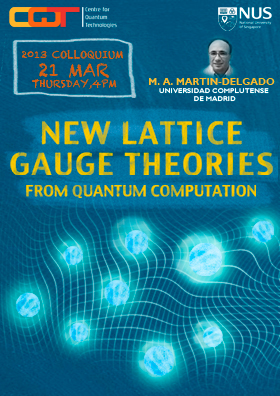 Miguel Angel Martin-Delgado, Universidad Complutense de Madrid
Miguel Angel Martin-Delgado, Universidad Complutense de Madrid Eric Cornell, JILA
Eric Cornell, JILA Peter Knight, Imperial College, UK
Peter Knight, Imperial College, UK Avi Wigderson, Institute for Advanced Study, Princeton, USA
Avi Wigderson, Institute for Advanced Study, Princeton, USA Andrey Varlamov, Institute of Superconductivity and Innovation Materials (SPIN-CNR), Italy
Andrey Varlamov, Institute of Superconductivity and Innovation Materials (SPIN-CNR), Italy Andrey Morello, ARC Centre of Excellence Centre for Quantum Computation and Communication Technology, The University of New South Wales
Andrey Morello, ARC Centre of Excellence Centre for Quantum Computation and Communication Technology, The University of New South Wales Dimitris Charalambidis, University of Crete and Institute of Electronic Structure and Laser (IESL), FORTH
Dimitris Charalambidis, University of Crete and Institute of Electronic Structure and Laser (IESL), FORTH Yuval Gefen, Weizmann Institute of Science
Yuval Gefen, Weizmann Institute of Science Peter Hanggi, University of Augsburg
Peter Hanggi, University of Augsburg Philippe Bouyer, Laboratoire Charles Fabry, France
Philippe Bouyer, Laboratoire Charles Fabry, France Gershon Kurizki, Weizmann Institute of Science, Israel
Gershon Kurizki, Weizmann Institute of Science, Israel Guido Burkard, Department of Physics, University of Konstanz, Germany
Guido Burkard, Department of Physics, University of Konstanz, Germany Raymond Laflamme, IQC, Waterloo, Canada
Raymond Laflamme, IQC, Waterloo, Canada Wojciech Zurek, Los Alamos National Laboratory, USA
Wojciech Zurek, Los Alamos National Laboratory, USA Immanuel BLOCH, Max-Planck-Institut fĂŒr Quantenoptik
Immanuel BLOCH, Max-Planck-Institut fĂŒr Quantenoptik Harry BUHRMAN, Centrum Wiskunde & Informatica (CWI) & University of Amsterdam
Harry BUHRMAN, Centrum Wiskunde & Informatica (CWI) & University of Amsterdam Elisabeth Giacobino, Laboratoire Kastler Brossel, Ecole Normale Supérieure, Université Pierre et Marie Curie, CNRS
Elisabeth Giacobino, Laboratoire Kastler Brossel, Ecole Normale Supérieure, Université Pierre et Marie Curie, CNRS Alån Aspuru-Guzik, Harvard University, USA
Alån Aspuru-Guzik, Harvard University, USA Michael Fleischhauer,UniversitÀt Kaiserslautern, Germany
Michael Fleischhauer,UniversitÀt Kaiserslautern, Germany 28 Jul 2011Boris Altshuler, Columbia University, USA
28 Jul 2011Boris Altshuler, Columbia University, USA Luca Turin, BSRC Fleming, Vari, Greece
Luca Turin, BSRC Fleming, Vari, Greece 24 Mar 2011Tom Gallagher, University of Virginia, USA
24 Mar 2011Tom Gallagher, University of Virginia, USA 10 Feb 2011Jeremy O'Brien, University of Bristol
10 Feb 2011Jeremy O'Brien, University of Bristol 09 Feb 2011Antonio Acin, ICFO, Barcelona (Spain)
09 Feb 2011Antonio Acin, ICFO, Barcelona (Spain) 11 Jan 2011Charles H. Bennett of IBM Research USA
11 Jan 2011Charles H. Bennett of IBM Research USA 07 Dec 2010Martin Plenio and Mario Szegedy
07 Dec 2010Martin Plenio and Mario Szegedy 07 Oct 2010Lev Vaidman, Tel Aviv University
07 Oct 2010Lev Vaidman, Tel Aviv University 09 Sep 2010Daniel M. Greenberger, City University of New York
09 Sep 2010Daniel M. Greenberger, City University of New York 20 Aug 2010Carlton M. Caves, University of New Mexico
20 Aug 2010Carlton M. Caves, University of New Mexico 10 Aug 2010Christophe Salomon, Laboratoire Kastler Brossel, France
10 Aug 2010Christophe Salomon, Laboratoire Kastler Brossel, France 27 May 2010Sankar Das Sarma, University of Maryland
27 May 2010Sankar Das Sarma, University of Maryland 22 Apr 2010John Rarity, University of Bristol
22 Apr 2010John Rarity, University of Bristol 18 Mar 2010Adrian Kent, Centre for Quantum Computation, University of Cambridge
18 Mar 2010Adrian Kent, Centre for Quantum Computation, University of Cambridge 24 Feb 2010Klaus MĂžlmer, Lundbeck Foundation Theoretical Center for Quantum System Research, University of Aarhus
24 Feb 2010Klaus MĂžlmer, Lundbeck Foundation Theoretical Center for Quantum System Research, University of Aarhus 08 Dec 2009Anton Zeilinger
08 Dec 2009Anton Zeilinger 08 Dec 2009Andrew Yao
08 Dec 2009Andrew Yao 19 Nov 2009Nicholas Bigelow, The Institute of Optics, University of Rochester
19 Nov 2009Nicholas Bigelow, The Institute of Optics, University of Rochester 29 Oct 2009Jean Dalibard, Laboratoire Kastler Brossel
29 Oct 2009Jean Dalibard, Laboratoire Kastler Brossel 03 Sep 2009Lieven Vandersypen, Kavli Institute of Nanoscience, Delft University of Technology
03 Sep 2009Lieven Vandersypen, Kavli Institute of Nanoscience, Delft University of Technology 16 Apr 2009Jörg Schmiedmayer, Atominstitut der ???sterreichischen UniversitÀten, TU-Wien
16 Apr 2009Jörg Schmiedmayer, Atominstitut der ???sterreichischen UniversitÀten, TU-Wien 02 Apr 2009Serge Haroche, ENS and CollÚge de France
02 Apr 2009Serge Haroche, ENS and CollĂšge de France 26 Mar 2009Patrick Hayden, McGill University, Canada
26 Mar 2009Patrick Hayden, McGill University, Canada 12 Feb 2009Ian Walmsley, University of Oxford, UK.
12 Feb 2009Ian Walmsley, University of Oxford, UK. 05 Feb 2009Wolfgang Behr, University of Zurich, Switzerland
05 Feb 2009Wolfgang Behr, University of Zurich, Switzerland 20 Jan 2009Seth Lloyd, Massachusetts Institute of Technology, USA
20 Jan 2009Seth Lloyd, Massachusetts Institute of Technology, USA 03 Dec 2008Philippe Grangier, Institut d'Optique, Palaiseau
03 Dec 2008Philippe Grangier, Institut d'Optique, Palaiseau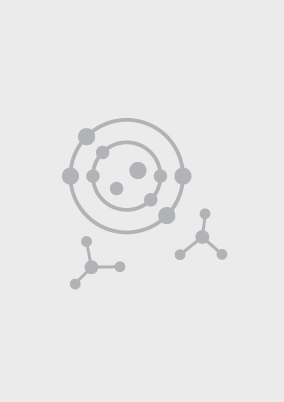 02 Dec 2008Jun Ye, JILA, National Institute of Standards and Technology and University of Colorado
02 Dec 2008Jun Ye, JILA, National Institute of Standards and Technology and University of Colorado 02 Dec 2008Alain Aspect, Institut dâOptique, Palaiseau
02 Dec 2008Alain Aspect, Institut dâOptique, Palaiseau 02 Oct 2008Kazimierz RzĂâŠĂ ?ewski
02 Oct 2008Kazimierz RzĂâŠĂ ?ewski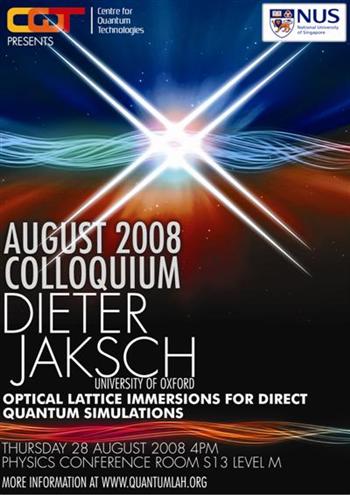 28 Aug 2008Dieter Jaksch
28 Aug 2008Dieter Jaksch 17 Jul 2008Rosario Fazio
17 Jul 2008Rosario Fazio 29 May 2008Howard Carmichael
29 May 2008Howard Carmichael 17 Apr 2008Scott Parkins
17 Apr 2008Scott Parkins 27 Mar 2008Hans Briegel
27 Mar 2008Hans Briegel 28 Feb 2008Nobuyuki Imoto
28 Feb 2008Nobuyuki Imoto 10 Jan 2008Nicolas Gisin
10 Jan 2008Nicolas Gisin



